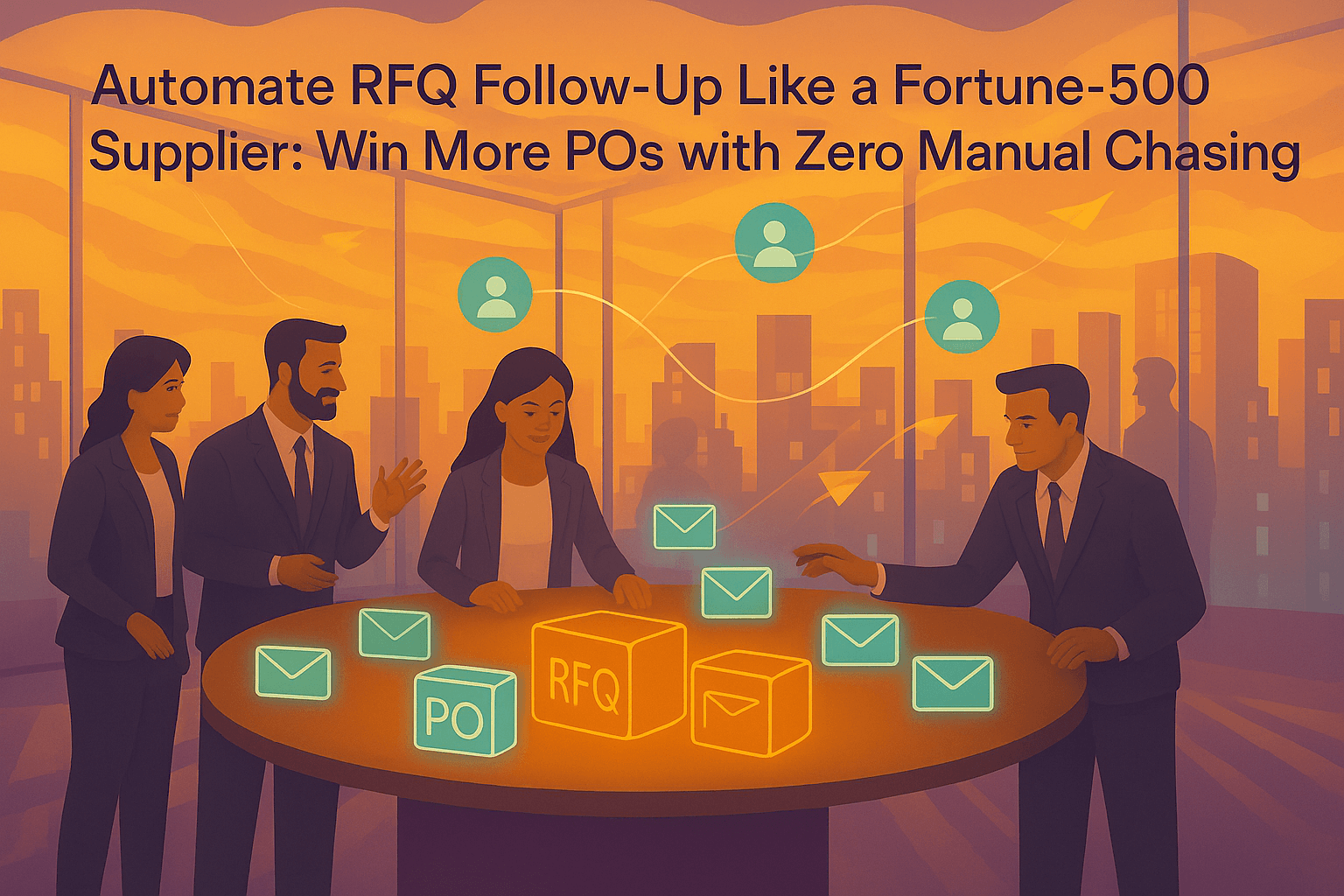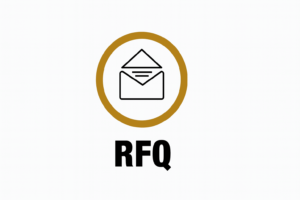The Quiet Killer of Custom Sales and RFP Processes — No Follow-Up
You quoted it. You sent it. And then… silence.
No reply. No confirmation. No close. Just another quote floating in someone’s inbox, aging by the hour.
For most custom industrial manufacturers, this isn’t a rare occurrence; it’s the norm. The quote process is complex: specs have to be reviewed, pricing aligned with engineering and procurement, and maybe even a lead time estimate sourced from production. It takes work to put together a quote. So it’s baffling how often that work ends with no system in place to follow through.
This isn’t just a sales team problem. It’s a business process failure.
And the cost is high—because in custom manufacturing, every quote matters. These aren’t $15 widgets someone might buy on impulse. These are high-ticket, spec-driven products, often for time-sensitive industrial projects. The moment the quote goes out, a clock starts ticking. The buyer is comparing vendors, securing approvals, and looking for signs of confidence and reliability. Vendors who follow up promptly signal their ability to provide consistent supply—not just a one-time quote. If your team doesn’t follow up quickly—and consistently—you’re not just risking the quote going cold. You’re sending the message that your operation doesn’t prioritize responsiveness.
Even worse, most manufacturers don’t realize how many quotes are dying quietly. There’s no dashboard showing quote engagement. No system that flags aging proposals. No workflow that escalates stalled deals. Just inboxes full of half-finished conversations and a sales team too busy chasing the next RFQ to circle back on the last one.
It doesn’t have to be this way.
What you need is a system that turns quote follow-up into a process—not a memory test. A set of triggers, reminders, and automated touchpoints that make sure no opportunity falls through the cracks. Because in this business, quoting fast is important, but following up smart is what closes the deal.
Why the RFQ Process in Custom Manufacturing Failures
In custom manufacturing, quoting isn’t transactional, it’s technical, collaborative, and full of dependencies. Which is exactly why follow-up tends to fall apart.
Unlike retail or off-the-shelf B2B, your quotes aren’t auto-generated. They’re built for complex projects that require coordinated input from sales, engineering, and operations. You’re confirming material availability, tolerances, lead times, and often pricing fluctuations tied to raw inputs or labor availability. It’s not a 10-minute task. It might take days. That means by the time a quote goes out, your team already feels like the job is half done—and that’s where trouble starts.
Because quoting isn’t the finish line. It’s the start of a window where speed, clarity, and communication determine whether or not the deal closes.
Custom buyers—especially in sectors like aerospace, OEM supply, or construction—are often under pressure themselves. They’re juggling specs, timelines, and procurement approvals. “If they don’t hear from you after receiving a quote, they assume one of two things: you’re too busy, or you’re not interested—which immediately puts you behind other qualified contractors who stay engaged. Either way, they go elsewhere.
Worse still, the complexity of your quoting process means the quote might land in someone’s inbox who isn’t the final decision-maker. Or maybe they needed an alternate material. Or maybe they forwarded the quote to a colleague, who asked a question no one replied to. Without follow-up, these leads just evaporate—no flags, no alerts, no visibility.
And unlike in DTC or traditional ecommerce, you don’t get second chances. If you’re quoting $14,000 worth of custom enclosures and the buyer’s project manager doesn’t hear back for a week, that job is probably already awarded.
Custom manufacturers are especially vulnerable to follow-up breakdowns because:
- Quotes are high-value but low-volume—each one matters.
- The sales cycle is long and technical—there’s no “buy now” button.
- The internal handoffs (sales to engineering to ops) are often ad hoc or undocumented.
- There’s no built-in system nudging reps when a quote goes cold.
You’re not losing deals because your quotes are bad. You’re losing them because your system has no memory. And in this space, silence doesn’t mean “maybe”, it usually means “lost.”
Anatomy of a Lost Quote
Every industrial manufacturer has lost quotes that should have closed. It’s rarely about price. It’s rarely about capability. More often than not, the quote simply slipped through the cracks.
Let’s walk through what that looks like in real life:
A request for quote comes in—maybe through a form on your site, maybe from an existing client via email. The part is complex. Engineering needs to validate the specs, maybe confirm tolerances or double-check if the material is in stock. The sales rep builds the quote, pulls pricing from two systems, and finally sends it out.
And then… nothing.
The quote is sent but not tracked. No one logs whether it was opened, downloaded, or even received. The rep moves on to other requests. There’s no reminder set, no system-driven follow-up, and no flag if the customer revisits the proposal a week later. Days turn into weeks. The quote ages silently.
Maybe the customer needed clarification on project details and didn’t want to chase you. Maybe they got a competing quote faster. Maybe they assumed your silence meant you weren’t interested in the job.
By the time someone on your team remembers to follow up—if they remember at all—it’s too late.
Building a Follow-Up Workflow Around Every Business Document You Send
If you’re generating custom quotes but relying on reps to manually remember follow-ups, you’re running on hope, not process. What you need is a workflow that takes human memory out of the equation and builds automation into the rhythm of your quoting cycle.
A good follow-up system doesn’t mean sending annoying “just checking in” emails every few days. It means tying your outreach to the customer’s engagement and creating internal visibility for every quote, from the moment it’s sent to the moment it’s closed—or marked lost.
When You Send a Quote
After a quote goes out, we quietly keep track of the basics; who got it, when it was sent, and the amount. No big announcement, just a behind-the-scenes note so we don’t lose track.
Then We Wait and Watch
Once it lands in their inbox, we pay attention to what happens next.
-
If it just sits there unopened for a couple of days, we assume they’re not super interested (yet), so we adjust how we follow up.
-
But if they open it a few times and don’t reply? That usually means they’re curious but maybe unsure. That tells us it’s worth digging in a little more.
A Quick Nudge (Around Day 2–3)
If they’ve looked at it but haven’t said anything, it’s time for a friendly ping.
Something simple like:
“Hey, just checking in. Did everything in the quote make sense? Let me know if you’d like to tweak anything—we’re flexible.”
Still Nothing? Let’s Get In There (By Day 5–7)
If it’s been nearly a week with no reply:
-
The system might drop a reminder on the sales rep’s desk
-
Or give the manager a heads-up to take a look and figure out what to do next
Either way, we’re making sure it doesn’t just disappear.
If They Reopen the Quote Later
Here’s the interesting part—if they go back to look at the quote again, click around, open attachments, etc., the rep gets pinged immediately. That’s a sign. People don’t reopen quotes for fun. Something’s on their mind, and that’s our cue to follow up quickly.
Last Try (After 10–14 Days)
If nothing’s come back after two weeks, we send one last message. Not pushy—just wrapping things up.
Try something like:
“Hi again—just checking in. We’re planning to close out this quote unless you need more time or want to make any changes. Let us know!”
Automating the Follow-Up—Tools and Triggers
Automation doesn’t mean turning your sales process into a robot. It means giving your team leverage—so they’re not relying on spreadsheets, inbox searches, or gut feelings to manage active quotes.
If you’re quoting custom work, and your follow-up process still depends on sticky notes and Outlook reminders, you’re burning opportunities daily. The good news? You don’t need to rebuild your entire stack. You just need a clear workflow and a few well-placed triggers.
Start with the Tools You Already Use
Are you quoting inside Shopify with a B2B extension? Are you generating quotes in HubSpot, Salesforce, or PipeDrive? Or are you using a custom quoting tool tied to your ERP? Wherever your quote originates, that’s your anchor point. From there, you can automate follow-up based on events.
Set the Triggers
- Quote Sent → Start the clock. This is the first automation point. A timestamp logs when the quote was delivered. A countdown starts in the background.
- Opened → Trigger smart touchpoint. If the customer opens the quote but doesn’t respond, an email goes out 48 hours later. It’s not a nag—it’s a helpful check-in:
“Saw you viewed the proposal—anything we can clarify or adjust?” - No Open in 3 Days → Escalate internally. This might be a task assigned to a rep: “Call to confirm they received the quote.” It ensures a bad email address or overlooked message doesn’t quietly kill the deal.
- Quote Revisited → Trigger immediate alert. If the buyer returns to the quote link five days later and views pricing again, the rep gets a ping. That’s a sign of renewed interest. A quick call or email at this point can close the deal.
- Time-Based Milestones → Workflow branches. After 7–10 days, you can:
- Auto-send a “last call” email with a pricing hold notice.
- Flag it for a sales manager review.
- Or, for strategic accounts, send a follow-up with alternative materials or adjusted lead time to re-engage.
Don’t Automate Blind — Use the Data
What makes automation valuable is context. Don’t treat all quotes equally. Use the quote size, customer history, or spec complexity to prioritize. A $700 job for a new prospect might get two touchpoints. A $47,000 quote to a longtime OEM partner gets five alerts across the team.
And most importantly, loop automation into your CRM and quoting tools. If your sales rep can’t see the last touchpoint, or if the system sends emails without showing them, you’re setting yourself up for failure.
Automation isn’t about replacing your salespeople—it’s about backing them up. It catches what they miss. It moves fast when they’re busy. And it makes sure the follow-up happens, even when the human doesn’t.
Smart Sequences, Not Spam
Automating quote follow-up doesn’t mean flooding your customer’s inbox with reminders every 48 hours. Industrial buyers aren’t ignoring you because they forgot, you’re competing with other vendors, procurement delays, or internal project decisions. And if your follow-up sequence sounds like a generic email campaign, you’re not just being ignored—you’re being filtered out.
The key is relevance. Every follow-up touchpoint should feel intentional. It should move the conversation forward, not just echo what’s already been said. That starts with context. A smart sequence adapts. If the customer opened the quote and clicked the link to download a spec sheet, the next message should acknowledge engagement, something like, “I saw you reviewed the datasheet—let me know if you need clarification on tolerance or lead time.” That kind of message isn’t spam. It’s service.
Likewise, if the quote has been sitting unopened, the tone changes. You might say, “Just making sure the proposal landed on your side—happy to resend or walk you through any details.” It’s a softer nudge, but it keeps the thread alive.
Even the final step shouldn’t be a boilerplate goodbye. It’s a chance to reframe value: “We’re archiving this quote on our end, but if your project timelines shift or you’d like alternate materials, we’re happy to revisit it.”
Smart sequences don’t blast, they guide. They react to what the customer’s actually doing. And most importantly, they let your reps take over at the right moment. When a customer replies or shows renewed interest, automation steps back and the human steps in—because that’s when relationships are built.
This is how you stay top-of-mind without being an inbox nuisance. Follow-up doesn’t have to be aggressive to be effective. It just has to be timed well, written with purpose, and rooted in the reality that your customers are busy—and your job is to make their next step easier, not louder.
Cross-Team Visibility — Sales, Engineering, and Ops in One System
A quote doesn’t live in a vacuum. It might originate with sales, but it passes through multiple hands before it becomes an order. Engineering often needs to validate specs or tolerances. Operations weighs in on lead time and production constraints. Sometimes procurement or finance needs to approve margins. And if any part of that chain is disconnected, the quote stalls—and follow-up gets clumsy or delayed.
The most common failure point? No one knows who’s holding the ball.
Maybe the rep thinks engineering is reviewing it. Engineering assumes it’s sent. Ops doesn’t know it’s urgent. And when the customer finally replies with a question, no one has context. By the time someone circles back with an answer, the moment has passed—and the buyer has likely moved on.
What fixes this isn’t more meetings or more CC’d emails. It’s a shared system that shows the quote status in real time, accessible to everyone involved. Sales should be able to see whether the quote was reviewed by engineering. Engineering should see if the quote has been sent or revised. Ops should know when a quote was accepted and what lead time was promised. No siloed updates. No guesswork.
You just need consistent data flow. Whether you’re using a CRM like HubSpot, a quoting platform, or even a custom Google Sheet pipeline, the key is clarity. Each quote has a status. Each step has an owner. Each update is visible to everyone who needs to act.
This also makes follow-up easier and more accurate. If the customer replies asking about material substitution, the sales rep shouldn’t have to ping engineering and wait a day for context. That information should already be part of the quote record. If the buyer needs expedited delivery, ops can check the status and respond in minutes—not after two internal email chains.
When the team has visibility, quotes move faster, follow-ups are sharper, and the customer sees a company that’s aligned and competent—not one that looks like it’s improvising.
And in a market where reliability closes more deals than price, that internal coordination isn’t a nice-to-have. It’s the reason you win.
Quote Recovery — How to Bring Cold Opportunities Back to Life
Not every quote goes cold because the customer chose someone else. Often, it’s because the timing wasn’t right, internal approvals stalled, or the buyer simply got pulled into something else. These aren’t lost opportunities—they’re dormant. The customer’s upcoming project may just have shifted, stalled, or slipped on their priority list. The right outreach can bring them back to life.
But you can’t treat every old quote like it’s still warm. Recovery follow-up needs a different tone. Less urgency, more curiosity. You’re not pushing—you’re reopening a door.
Start by identifying quotes that aged out of your normal follow-up window. Maybe they’re 30, 60, or 90 days old. Instead of blasting the same message to all of them, filter by type: large custom jobs, repeat customers, and complex spec requests. These deserve a human touch—not just an automated “still interested?” email.
The best re-engagement messages are framed around change:
- “We’ve updated our lead times—would now be a better fit for your timeline?”
- “We have a new material supplier that may reduce cost for your spec—want us to re-run pricing?”
- “That quote you requested last quarter—if the project is moving again, we’d be happy to revisit it.”
These aren’t random follow-ups. They’re reminders that you’re paying attention, and that your business evolves, just like theirs does.
You can also use quote recovery data to sharpen your overall process. Why did these deals stall? Were specs unclear? Was pricing delayed? Did a technical approval never happen? Logging this insight turns quote loss into intelligence. It tells you what to fix upstream—so fewer quotes go dark in the first place.
A well-run quote recovery system isn’t just about reviving old business. It’s a feedback loop. It shows you where your sales process is breaking down—whether it’s slow engineering handoff, lack of follow-up clarity, or pricing misalignment. Every “no” or “never heard back” holds a clue to improve your next 50 quotes.
Some manufacturers even formalize this. Once a quarter, they run a dormant quote review: sales, engineering, and ops sit down with a list of unconverted quotes over 30 days old. They sort what’s still active, what’s worth revisiting, and what needs a new approach. That small investment of time often surfaces real revenue that would’ve otherwise died quietly in a spreadsheet.
Remember, buyers don’t always follow up with bad news. They just go quiet. And that silence doesn’t always mean they’ve moved on. It might mean they got stuck, delayed, or distracted. When you re-enter the conversation with relevance and insight you give them a reason to reengage.
Metrics That Matter — How to Track Quote Follow-Up Performance
If you’re not measuring follow-up, you’re guessing. And in custom manufacturing, guessing is expensive.
Most teams track how many quotes they send, maybe how many they win. But what happens in between—those 3 to 10 days after a quote goes out—is where conversion is won or lost. That window is invisible unless you’re tracking the right things. Not vanity numbers. Not activity for activity’s sake. Just a handful of focused, actionable metrics that show how well your quote process is actually working.
Start with response time. How long does it take for your team to send the first follow-up after a quote is delivered? If that number is more than 72 hours, you’re probably bleeding deals. Customers who don’t hear back quickly often assume you’re not serious—or they’re already halfway through onboarding with someone else.
Next, track quote engagement. How many quotes are opened within the first two days? How many are opened multiple times without a reply? If your system isn’t showing this, you’re flying blind. Opened-but-no-response quotes are golden—they mean the customer is thinking about it. That’s your priority queue for sales.
You also want to measure quote-to-close time. Not just win rate—but how long it takes to win. Are your fastest-responded quotes closing faster? Probably. Are quotes over 14 days old closing at all? Probably not. That trend tells you when a deal is still alive and when it’s already gone cold—even if the CRM status still says “pending.”
Don’t ignore cold quote recovery rate either. How many deals are you salvaging through proactive re-engagement? Even 5–10% recovered over a quarter can mean a serious revenue difference, especially in high-ticket or project-based manufacturing.
Finally, get visibility into follow-up coverage. What percent of sent quotes receive at least one structured follow-up within five business days? Not casual replies, not one-liners—measured, intentional outreach. That metric alone will expose the gap between what your team thinks it’s doing and what’s actually happening.
When you track these metrics consistently, your quoting process shifts from reactive to operational. You stop relying on rep intuition. You stop hoping someone followed up. You start knowing what’s moving, what’s stuck, and what needs help now—not when it’s too late.
RFQ Follow-Up Toolkit: Industrial Manufacturers Edition
Turn quotes into closed deals with systemized, trackable, and human follow-up sequences.
Follow-Up Performance Dashboard
Track these key metrics weekly or monthly to maintain accountability:
| Metric | Target / Goal | Notes |
| % of Quotes with Follow-Up <5 Days | ☐ 90% or higher | Ensures timely response post-quote |
| Quote Open Rate (First 72 hrs) | ☐ 70–80% | Indicates deliverability + recipient engagement |
| Quote Revisit Alerts Triggered | ☐ Logged + actioned within 24h | Use as sales priority signal |
| Quote-to-Close Average Time | ☐ <14 days for warm quotes | Compare across product types or deal sizes |
| Cold Quote Recovery Rate | ☐ ≥10% re-engaged within 90 days | From reactivation or re-pricing efforts |
| Sales Visibility Coverage | ☐ 100% quotes traceable by status | Shared visibility across Sales, Eng, Ops using unified status tracking |
Tool & Trigger Integration Table
| Use Case | Tool / Layer | Trigger Setup |
| Quote Sent → Follow-up clock | CRM or quoting platform (e.g. HubSpot) | Timestamp + owner tag |
| Opened but no reply | Email tracker (e.g. Yesware, Outfunnel) | Trigger follow-up template on open delay |
| Cold Quote Alert | CRM workflow / Zapier | Set alert at 10-day and 30-day no response |
| Revisit / High Engagement | Email tracking / Proposal software | Instant rep notification |
| Final “close or keep open” | CRM automated email | Trigger after Day 14 inactivity |
Sales-Engineering-Ops Quote Visibility Map
| Status | Viewable In | Who Needs Access | Next Action |
| Quote Draft | CRM / Shared Sheet | Sales, Engineering | Internal spec validation |
| Quote Sent | CRM, Email system | Sales, Ops | Confirm delivery + ownership |
| Customer Viewed | CRM / Email logs | Sales | Trigger follow-up |
| Customer Responded | CRM | Sales, Engineering | Revise quote / Confirm change |
| Quote Approved | CRM + Production system | Ops, Sales | Schedule delivery + update ETA |
| Quote Aged (30+ days) | Quote Recovery List | Sales Manager | Re-engagement review |
Smart Follow-Up Templates
| Scenario | Suggested Message Snippet |
| No response after 2 days | “Just wanted to check that the quote landed — happy to resend or clarify anything.” |
| Opened twice but no reply | “Saw you had a look — anything we can adjust or clarify to help you decide?” |
| Reopened after 5+ days | “Looks like the project may be moving again — want us to refresh pricing or specs?” |
| 10-day close-out message | “Unless you’d like to keep it open, we’ll archive this quote Friday. Let us know either way.” |
| 30-day cold recovery | “We’ve updated availability — would this quote be worth revisiting on your side?” |
The Fastest Quote Doesn’t Always Win. The Smartest Follow-Up Does.
There’s a myth in custom manufacturing that speed wins the job. That if you’re first to respond, first to price, and first to send a PDF, you’ll lock it in. But the reality is more nuanced.
Sure, speed helps. But what closes deals isn’t just how fast you respond. It’s how well you follow through.
Because quoting isn’t the finish line. It’s the start of the buyer’s decision cycle. And your buyer isn’t just comparing numbers. They’re judging responsiveness. They’re looking at who seems buttoned up, who answers follow-ups clearly, and who stays on top of the conversation without being a pest. In other words, who makes it easiest to say yes.
That’s why automation matters—not as a shortcut, but as an infrastructure layer. A way to make sure no quote goes dark. A way to show buyers, through action, that you’re ready, attentive, and consistent.
The shops that win aren’t just the fastest. They’re the most present. They have systems in place that make every customer feel like they’re being watched in the best possible way. That someone is still thinking about their job. That the quote they received wasn’t a one-off but the start of something worth continuing.
You don’t need a bigger team to follow up better. You need a better process. One that tracks, reminds, nudges, and keeps every open opportunity alive until it closes—or gets an intentional no.
That’s how you stop letting quotes expire quietly.
That’s how you turn quoting from a bottleneck into a sales engine.
Want to learn how we can help you follow up smarter? Contact us today.












